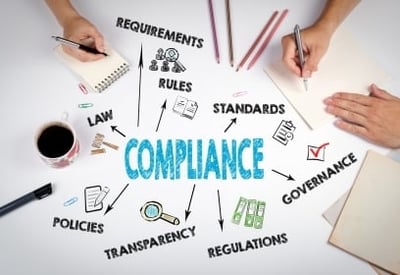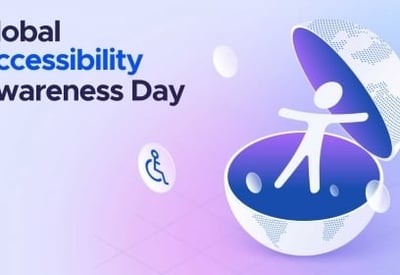To celebrate Global Accessibility Awareness Day 2025, Mobility Mojo joined accessibility leaders in a dynamic virtual panel discussion organised by Disability:IN. Moderated by Joan Bowen, Disability:IN EMEA Corporate Inclusion Consultant, the conversation explored the transformative impact of the European Accessibility Act (EAA) on businesses and citizens across Europe.
Mobility Mojo’s co-founders Noelle Daly and Stephen Cluskey spoke alongside Clare Connellan, co-lead for sustainability and responsible business practice at White & Case and Irfan Ali, vice president and global head of digital accessibility at Blackrock.
The panelists shared insights, practical guidance and real-world stories, making a compelling case that in an increasingly connected world, accessibility is no longer an option, it’s a strategic business imperative.
Understanding the European Accessibility Act
Clare Connellan set the stage with a concise overview of the EAA. With implementation deadlines approaching, particularly for new products and services launching from June 2025, companies urgently need to align with these standards. Clare noted that many multinationals, especially those with different products at varying maturity levels, are struggling to achieve comprehensive, practical compliance across complex operations.
She explained that in the EU, member states set enforcement policies and penalties when they transpose directives into national laws. However, the EU requires member states to have penalties that are "effective, proportionate and dissuasive.” Overall, Clare stressed that the regulation aims to establish a unified minimum standard for digital accessibility, overcoming fragmented regulations across the EU. She summarised its essence as: "If you meet the minimum standard, you meet the requirements in all member states."
[Read more about the EAA].
Stephen Cluskey kicked off the conversation around physical accessibility, stating that while the EAA primarily targets digital products, it “creates a holistic framework where digital and physical accessibility must work together.”
Stephen explained that the regulation requires companies to provide accurate accessibility information about their physical locations on their websites, emphasising that companies need a scalable and consistent method for obtaining reliable accessibility data across their locations. He highlighted that one of the biggest challenges companies face is "creating seamless accessibility experiences that bridge both the digital and physical environment gap.”
Noelle Daly weighed in, noting that much of the apprehension around the EAA stems from companies viewing it purely as regulatory compliance rather than seeing its true purpose—“to remove barriers and ensure that products and services are more accessible by everyone.” From that perspective, the EAA has a “huge compelling business advantage.” With nearly 90 million people in the EU living with a disability, compliance unlocks new markets and drives growth.
Turning regulation into opportunity
Irfan Ali shared insights from Blackrock's multinational perspective, underscoring significant challenges presented by legacy systems filled with accessibility gaps. He explained, "Remediating those gaps while maintaining functionality and regular business is a time-sensitive and resource-heavy task." However, he also emphasised that proactive remediation strengthens digital products, improves client experiences, and sets industry benchmarks.
Irfan also applauded the EAA’s strength when compared to similar legislation elsewhere, stating "This law has teeth.” For many organisations, accessibility has remained on the backburner, managed reactively. The EAA’s penalties and enforcement mechanisms have elevated accessibility from a secondary concern into a governance priority. Leadership teams, he noted, “are talking about accessibility now.”
Bridging digital and physical accessibility
Noelle talked about how the EAA’s appendix has a built environment component to ensure that the regulation makes the covered products and services more accessible in practice and not just on paper. "An accessible ATM is no good if someone in a wheelchair can’t get into the bank,” she explained.
Noelle discussed the EAA’s built-environment component, designed to ensure covered products and services are accessible in practical terms. "An accessible ATM is no good if someone in a wheelchair can’t get into the bank," she pointed out. She emphasised the necessity of integrated approaches for interpreting and applying complex accessibility standards, especially in sectors like banking and retail.
Stephen pointed out that scaling physical accessibility is a particular challenge for companies operating numerous buildings across Europe. Traditional accessibility audits often prove expensive, inconsistent (due to local legislative variations) and time-consuming.
He also acknowledged that budget constraints and older buildings pose genuine accessibility challenges, highlighting Amsterdam as a prime example where small lifts often can't accommodate wheelchairs. To tackle accessibility in a realistic way, he recommended categorising improvements into "CapEx Light" (low-cost, high-impact fixes under €3,000) and "CapEx Intense" (larger-scale, long-term projects). This structured approach helps businesses prioritise immediate accessibility improvements while planning strategically for future renovations.
Highlighting quick-win opportunities, Noelle recounted a memorable audit with a banking client: when checking for screen glare on an ATM, three queued customers wearing glasses spontaneously confirmed the issue, illustrating how simple changes—such as relocating ATMs—can significantly enhance user experience. She also provided actionable advice for securing funding support for larger improvements, referencing available European incentives, regional development funds, and sector-specific grants.
Noelle then explained that many positive accessibility outcomes result from simply educating teams about practical improvements, such as repositioning ATMs, adding alt text to images and ensuring digital products support assistive technologies.
Drawing on his personal experience, Stephen shared insights into how assistive technology empowers individuals, demonstrating his own use of a head mouse and expressing enthusiasm for emerging AI-powered tools.
Concluding the discussion, Stephen framed the EAA’s long-term impact as the “normalization of accessibility [as a] standard business practice rather than a special accommodation. When that happens, we will have truly transformed the European business landscape into one that includes and values everyone, regardless of their situation or their ability.”

/curves%20(4).png?width=720&height=720&name=curves%20(4).png)



/man-with-service-dog.jpg?width=720&name=man-with-service-dog.jpg)
/curves.png?width=720&height=720&name=curves.png)